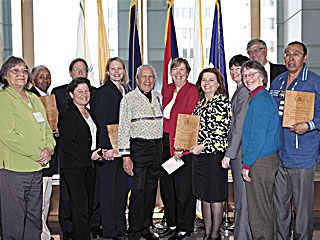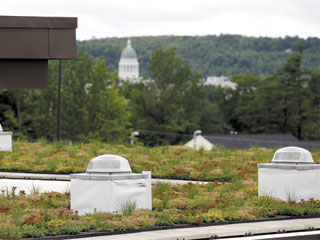Onondaga Nation and environmental partners win prestigious EPA award
By Gale Courey Toensing
The Environmental Quality Award was given to the Onondaga Nation, Onondaga County Executive Joanne Mahoney, the Partnership for Onondaga Creek, and Atlantic States Legal Foundation April 23 at a ceremony in New York where several individuals and groups were recognized for their efforts to restore and protect the environment.
“Today we honor those who advocate for a better environment, and give their time and energy to make the world a healthier and cleaner place,” said EPA Regional Administrator Judith Enck. “The people and organizations we honor today are truly making a difference and we thank them for their part in helping us shape a more sustainable environmental future.”
The coalition was awarded for its “Greening Syracuse’s Combined Sewer Overflow Long Term Control Plan” – a plan the coalition calls “a just and sustainable solution” to Onondaga County’s combined sewer overflow problem.
Syracuse, like other older cities, has a century-old combined system in which storm water runoff runs into the sewer system. For decades untreated sewage and runoff was pumped directly into Onondaga Creek. The creek flows through Onondaga Nation territory and into Onondaga Lake, which is considered sacred by the nation. Onondaga County is under court-order to reduce the CSOs flowing into Onondaga Creek and Harbor Brook, another nearby waterway.
The county’s prior plans relied on expensive end-of-pipe “swirler” plants to disinfect sewage before dumping it into the creek, but that method failed to treat for either nitrogen or phosphorous. The plan intended to locate treatment plants in low income, mostly African-American neighborhoods in what some felt was a blatant act of environmental racism. And it proposed installing a 12-foot-diameter concrete pipe along a 1.5-mile route that would disrupt the neighborhood.
The unique coalition of Indian nation, grassroots environmental activists and county government officials formulated an alternative to the construction of three regional wastewater treatment facilities that were to be built in downtown Syracuse. Instead, the partners proposed underground storage and green infrastructure, which was approved by the Onondaga County legislature and is in the process of being implemented.
 |
|
Photo courtesy Robin
Holland The Onondaga Nation and its coalition partners – Onondaga County Executive Joanne Mahoney, the Partnership for Onondaga Creek, and Atlantic States Legal Foundation – were awarded an Environmental Quality Award by the U.S. Environmental Protection Agency in recognition of the coalition’s successful work to create a more just and sustainable solution to Onondaga County’s combined sewer overflow problem. The award was presented in New York April 23, during the United Nations Permanent Forum on Indigenous Issues. Pictured, from left, are Jeanne Shenandoah, Onondaga, Eel Clan; Lionel Logan, POC president; Tarki Heath, POC; Joe Heath, Onondaga Nation general counsel; Mahoney; Oren Lyons, Onondaga Nation faithkeeper, Turtle Clan; Judith Enck, EPA Region 2 administrator; Vita DeMarchi, representing ASLF; Jean Smiley, Onondaga County; Aggie Lane, POC; Chris Beck, representing ASLF; and Tadodaho Sidney Hill, Onondaga Nation. |
Green infrastructure involves
hundreds or perhaps thousands of small projects to decrease the
amount of impervious surfaces such as sidewalks, streets, parking
lots and rooftops. These hard surfaces don’t allow water to seep
into the ground to be filtered clean before entering waterways such
as Onondaga Creek. Impervious surfaces create polluted runoff that
flows directly into the nearest body of water.
Green infrastructure includes such things as permeable pavements in
parks, parking lots and basketball courts, vegetated rooftops, rain
gardens, cisterns, tree plantings and constructed wetlands to manage
storm water runoff.
The award ceremony took place at the EPA’s office in downtown
Manhattan.
“It was a very positive and upbeat ceremony,” said Joe Heath,
Onondaga Nation general counsel. “It felt good to share with a
number of other people from around the New York region that were
given awards. It really marks a remarkable turnaround in our
relationship with the EPA and environmental agencies generally.”
Heath recalled that more than 10 years ago he and one of the
Onondaga Nation chiefs met with EPA officials to discuss the
nation’s concerns about the pollution in Onondaga Creek, but to no
avail.
Now, significantly, the EPA chose Onondaga Nation Faithkeeper Oren
Lyons, Turtle Clan, as the keynote speaker at the awards ceremony,
Heath noted.
“So, all in all, to go from being totally excluded from the decision
making process when the nation’s views were just flatly rejected to
receiving that award on the same subject meant a great deal both to
the nation and this office. And it reflects a change that
traditional ecological knowledge is now being accepted much more
openly, at least in this area,” Heath said.
The Partnership for Onondaga Creek is a grassroots environmental
justice organization that started in 2000 by neighbors who were
disturbed by the local government’s proposal to build a treatment
plant in their downtown Syracuse neighborhood.
The Atlantic States Legal Foundation is a nonprofit environmental
organization established in 1982 to provide affordable legal,
technical and organizational assistance to individuals, community
groups, and other non-governmental organizations as a way to
effectively remediate threats to the natural environment.
In the 1980s, ASLF used the citizen suit provision of the Clean
Water Act and sued Onondaga County to force it to upgrade the large
sewage treatment plant on Onondaga Lake that “was contributing
horribly to the lake’s pollution,” Heath said.
The Onondaga County government was intransigent in dealing with the
problems until the election two years ago of Mahoney, Heath said.
“For 10 years, we were losing and being ignored by the former county
administrator, not getting along with the DEC (New York state’s
Department of Environmental Conservation), and not getting any help
from the former administrator in the EPA. Joanne came in and made a
very bold decision within her first month in office to scrap the
plans for treatment plants,” Heath said.
The Onondaga Nation played a key diplomatic role in bringing all
parties back to the table in 2008 shortly after Mahoney took office,
and negotiating “a more holistic solution” to the problem, Heath
said.
“And the change is remarkable in that people can – whether
consciously or not – apply one of the principles of the Great law of
Peace of the Haudenosaunee, which is everybody should bring their
good minds together and find a solution that’s best for everybody.”
© 1998 - 2010 Indian Country Today. All Rights Reserved To subscribe or visit go to: http://www.indiancountry.com
